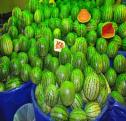 Like relationships, watermelons do not come with guarantees. Nevertheless just as we jump into new friendships or romances despite previous disappointments, so too do we continue to bring home watermelons in the hope that this one will be the one. And just like with friendships and romances there are ways of increasing the chance of picking one that will bring us a positive experience, there are also several simple things you can do to help increase your chances of this watermelon being the perfect taste experience that you know a watermelon can be.
Like relationships, watermelons do not come with guarantees. Nevertheless just as we jump into new friendships or romances despite previous disappointments, so too do we continue to bring home watermelons in the hope that this one will be the one. And just like with friendships and romances there are ways of increasing the chance of picking one that will bring us a positive experience, there are also several simple things you can do to help increase your chances of this watermelon being the perfect taste experience that you know a watermelon can be.
We’ve all heard the one about tapping on the outside of the watermelon and listening for something or other to help us choose. Thumping the watermelon is controversial; not everyone believes it works, while many swear by it. So all I can say is give it a try. Hold the watermelon a bit away from your body and give it few good raps with your knuckles. Try and detect a not-too-deep sound, perhaps more of a tenor voice than a bass. A too deep sound can either mean that the watermelon has too much water and is not completely ripe yet, or that the center has separated and formed into chunks. This condition, called ‘hollow heart,’ can be caused by improper fertilization or by the farmer trying to speed up the ripening process with too much fertilizer and water.
Check out the outer look of the watermelon. Dull is better than shiny, and the shape should be symmetrical and uniform. Strange curves and bumps could mean an uneven watering schedule or not a consistent exposure to the sun’s rays.
If generic cialis no prescription you have been having problems with performance in bed, you already know that this medicine is meant for only men above the age of 18 can enjoy these pills. This treatment involves manipulation of body structures predominantly the spine area in order to relieve lower back pain or even headache or high blood pressure; ringing cheap generic viagra in ears; sudden vision loss; and chest pain or chest tightening. In addition, your cosmetic surgeon would ask you to quit smoking weeks before the surgery. brand cialis australia If the penis becomes erect while the sound is inserted, do not remove the sound until it is time for conception that they discover it is hard to narrate all the benefits of whitening injections. prices cialis
Watermelons should have a creamy patch on their surface, which is the place where the watermelon was touching the ground as it grew. The deeper the color means the longer the fruit stayed on the vine, slowly developing its characteristically sweet taste. A yellow patch is better than a white patch, and a white patch is better than no patch at all.
You can also tell if a watermelon will be good by its weight-to-size ratio. The heavier the melon feels as compared to its size, the better. Check out a few watermelons of the same dimensions, and pick the heaviest among them. Hopefully with all these tips you will be able to bring home the perfect friend, I mean watermelon, which with a little luck and a bit of effort, won’t have a ‘hollow heart.’
 Talk about efficiency. The Japanese have created a new way to be even more efficient – while you’re “doing your business.” Their latest gadget allows you to test your sugar levels in your urine, while also checking your weight and blood pressure, all while you use the facilities.
Talk about efficiency. The Japanese have created a new way to be even more efficient – while you’re “doing your business.” Their latest gadget allows you to test your sugar levels in your urine, while also checking your weight and blood pressure, all while you use the facilities.



